One of my main goals while living in Europe was to visit the world famous and one of a kind Dachshund Museum in Passau. And, this summer, I was able to fulfill this dream. Of course, it took me a little longer to get there than expected.

Passau is sometimes called Die Drei Flüsse Stadt (Three River City). This namesake is a result of it being the convergence the Danube, Inn, and Ilz rivers. It is a small town, but houses a renowned university (University of Passau) in Germany and is rich with Bavarian culture and Baroque architecture. It is a balance of touristy and local charm.
However, it takes some time to make it there.
A Cancelled Train Arrives
Getting from München to Passau takes two hours in either direction. The Bavarian countryside is a splendid backdrop to have while travelling on the rail. As one leaves the cosmopolitan München, what makes Bayern, really Bayern becomes more apparent.
Mountainous terrain, rolling fields, small, charming villages, oxidised copper tops and red tile roofing with a sense of fairytale wonder in little passing pockets.

Passau is a rather small municipality. The Hauptbahnhof is located away from the main touristic and business centres. So, do not expect to be enveloped in the local cuteness until maybe 15 minutes of schlepping toward the town’s main point on the water. It is adorable, but a bit expensive as a result of its emerging tourism industry.

(Photo credits by PintsizedPioneer)
With free WiFi in certain parts of the city and heavy promotion of its art and cultural museums, it is obvious that the town is looking for visitors. As we have seen with other locations (especially in Europe), let us hope that over-tourism does soon plague the town anytime soon.

So, anyway, arriving to Passau …
Of course, Deutsche Bahn let me down again. I, along with a handful of other passengers, were stranded in München after our train was cancelled, abruptly. It is possible to file a claim with Deutsche Bahn in case of long delays and cancellations, but customer service is terrible with them. The company contacted me after I filed my other claim, but since then, have not heard anything from them.
Luckily, despite all our understandings on the platform, the cancelled train ended up arriving maybe 45 min – 1 hr. Sometimes, it pays to wait aimlessly on the track.
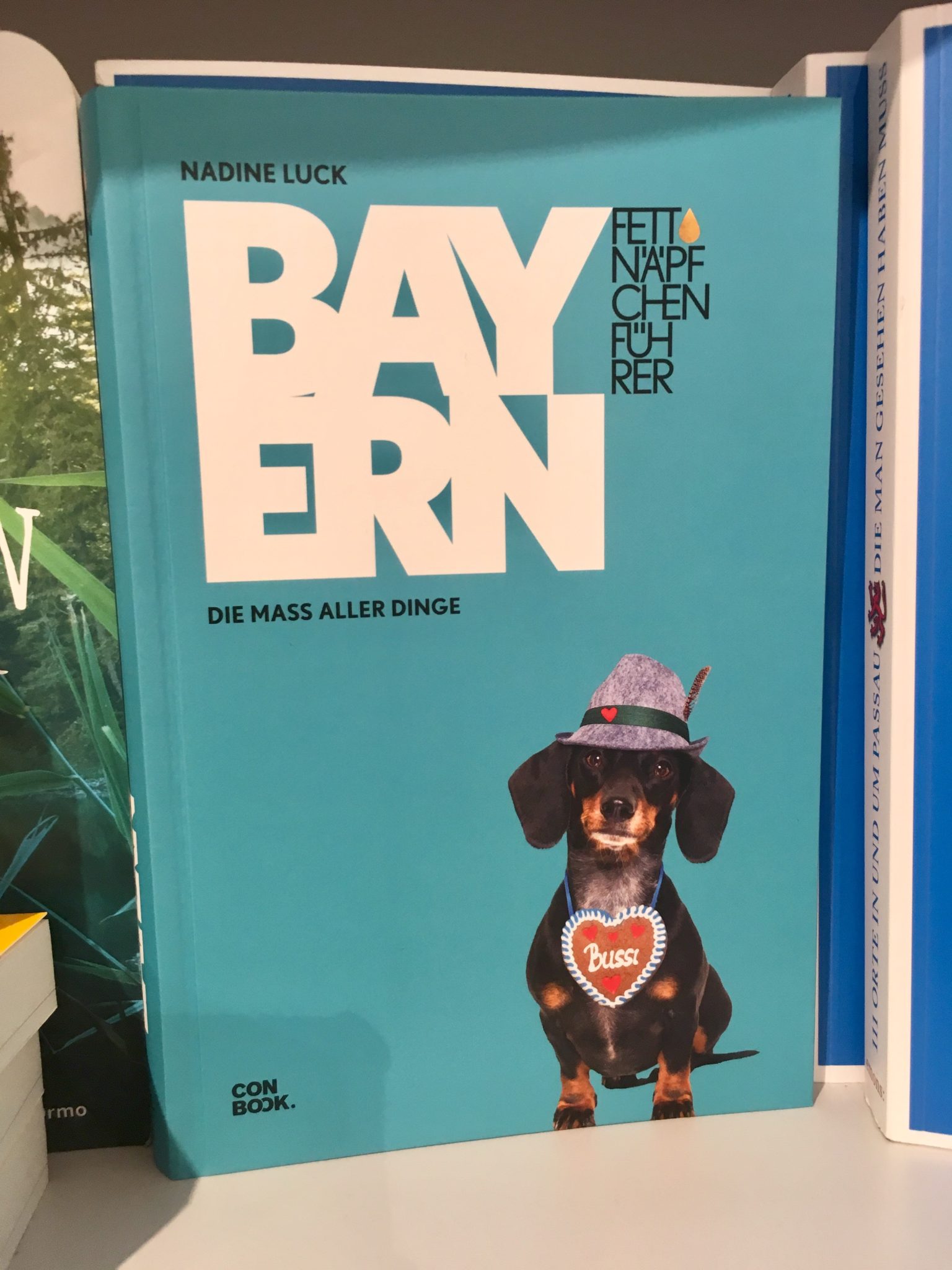
Overall, it was bizarre, but eventually I with my Bavarian compatriots could board the right train, and we were on our way.
DACKELMUSEUM: Dachshund Museum
The main draw to Passau for me was clearly the wiener dog museum. Interestingly, the modern German word for this breed of low hanging sausage-shaped canids is (der) Dackel, not dachshund, which would translate as literally ‘badger hound’. It is a bit of a case archaic language being preserved while the German language has continued evolving since this term was coined.

Opened about a year ago (April 2018), the Dackelmuseum is the creation of florists Josef Küblbeck and Oliver Storz who have their own little treasures, Seppi and Moni: beautiful, standard (I believe) black, smooth-haired dachshunds.
The museum houses over 4,500 wiener dog themed pieces in a small, but expansive gallery next to Residence Square. The Museum is charmingly called Kleine Residenz ‘little residence’ in reference to its locale.
Sausage dogs are rather emblematic of the region and Bavarian culture. They are common in iconography and historically, the pets of the wealthy.
This trend extends into modern times with famous owners like Pablo Picasso, Andy Warhol, and even Adele. The breed was originally bred for badger hunting; their bodies perfect for tunnelling to get rodents too. However, today, they are mostly seen as lap dogs with attitude.
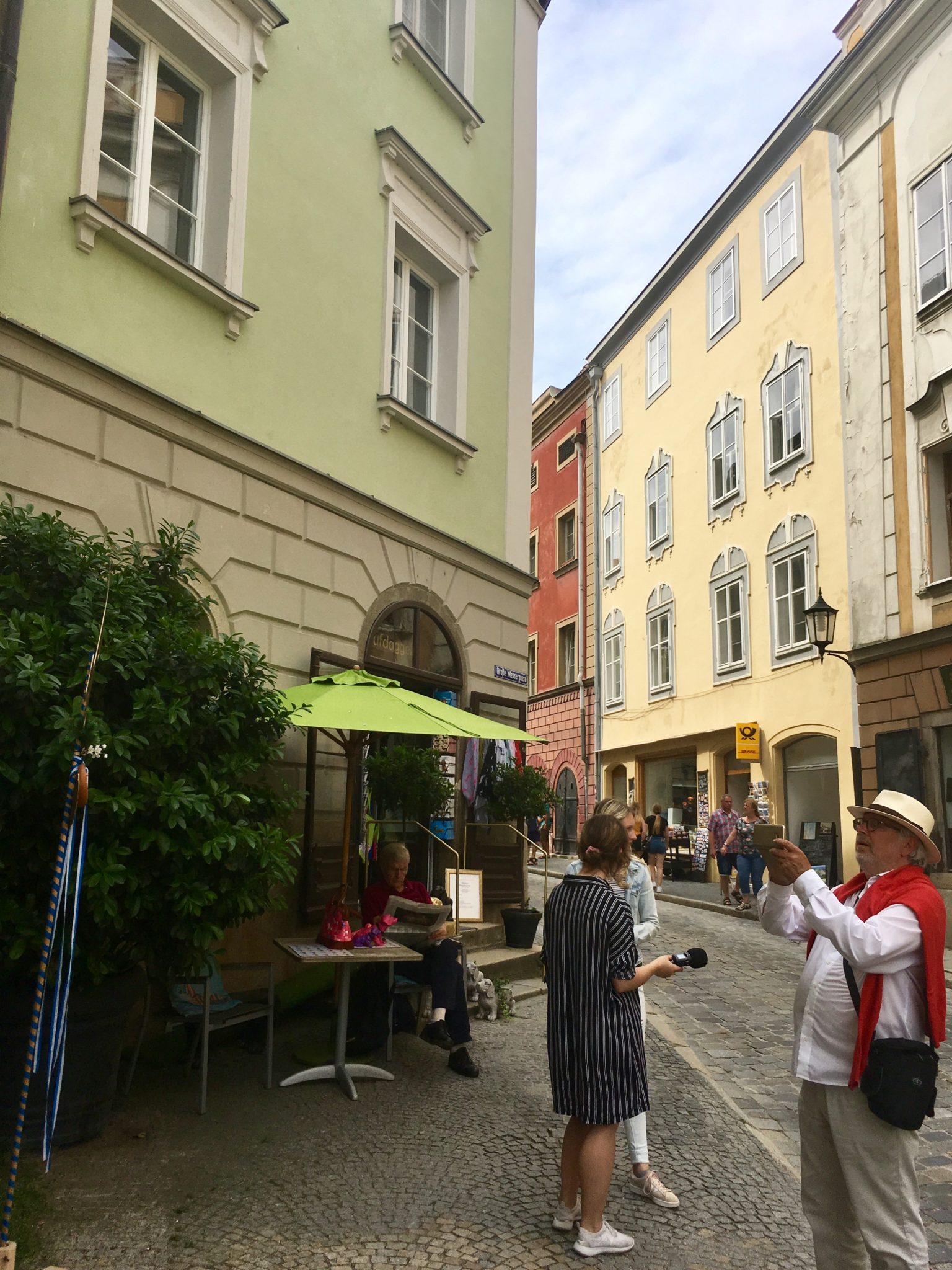
The museum has a small window (10 AM – 4 PM) for visitors to see the gallery and shop for theme souvenirs. (I opted for some relatively cheap buttons and magnets.) During Christmas and much of January, the museum itself is closed. I arrived to Passau around 3 PM, so I sprinted from the train station to the museum, following the well-marked municipal signs, to ensure I could enjoy and savour my time there.
Entry for students is € 3.00, adults € 5.00, and children (below 12) are free!

The entry ticket itself is a dachshund-themed postcard. And, one also receives an autographed postcard from the couple and the adorable pair of Seppi and Moni (paw prints and all) with purchase. Brochures cost € 5.00 extra.
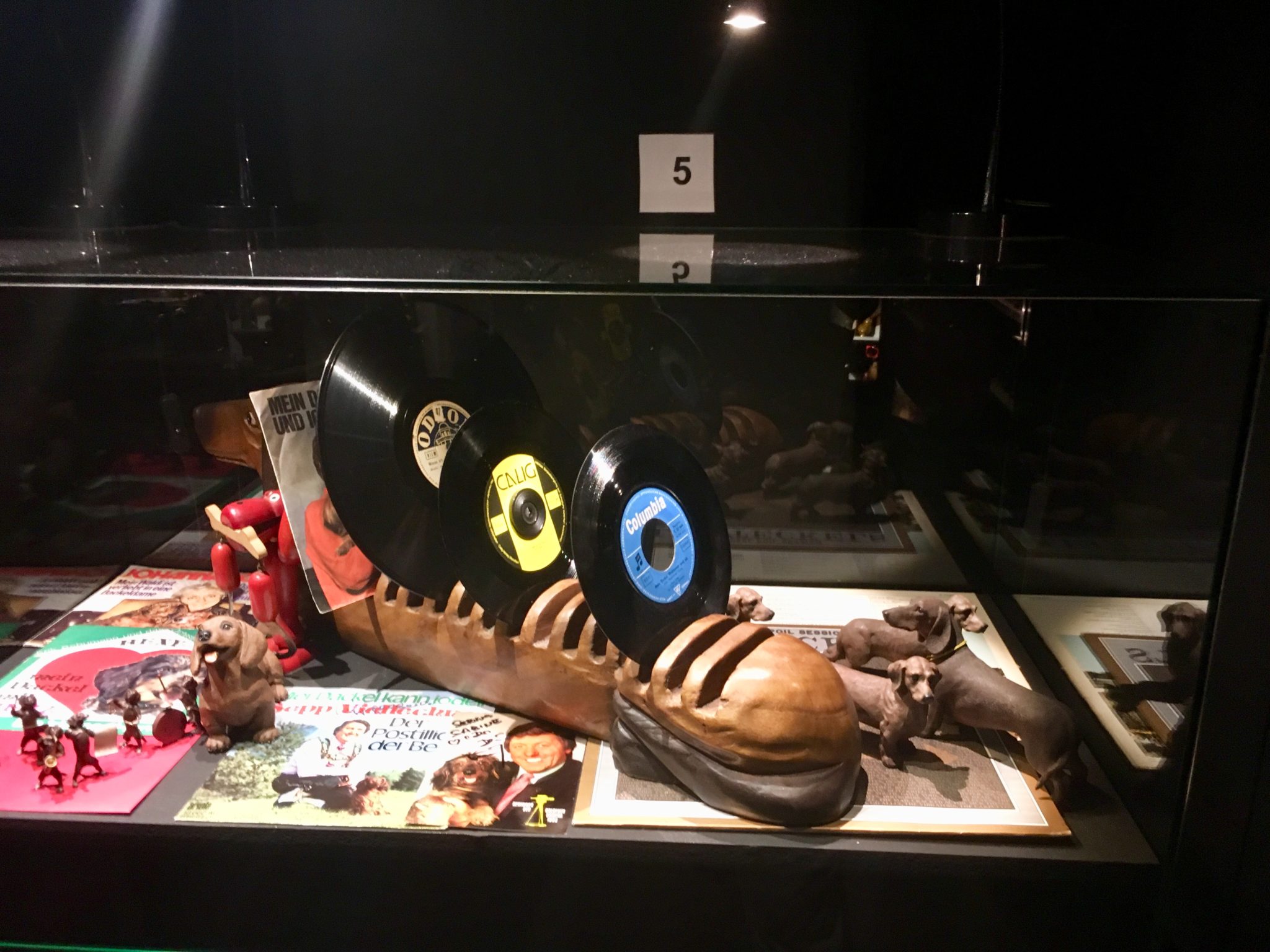
I spoke with Josef a bit (while winded from my run in the scorching Bavarian heat) about my own dachshund and how far I travelled to get there. As I began my tour, I was lucky to meet Seppi and Moni, who smothered me in kisses, with Oliver on the lead to answer more questions.

Again, although small, the museum is rather expertly curated. It is always difficult to design and manage a small space for exhibitions. For that reason, how one utilises height, depth, light, and sound matter even more so to create artificial space or the illusion of barriers.
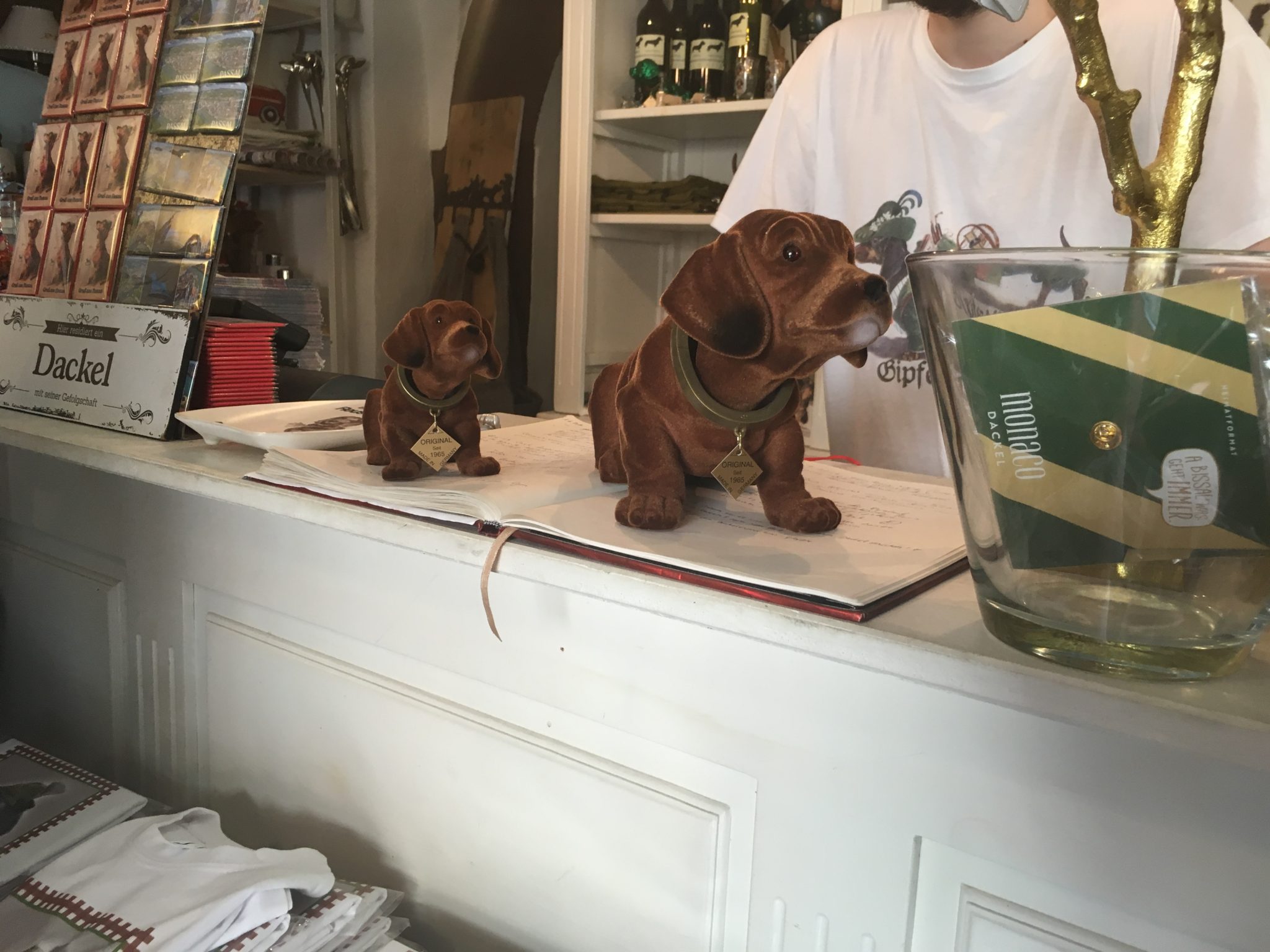
With rich audio-visuals, detailed explanations of Dachshunds historically and culturally in Bavaria, Germany, and worldwide, it is a superb mini-museum.
dackeln (v). – to waddle or walk slowly (like a dachsund)
After spending a considerable amount of time at the museum, I exited into the blistering climate of southern Germany in search of something to eat. The summer heat waves are truly the new (terrible) normal in temperate Germany. It is scary and concerning.
Much of this tourism industry revolves around the commodification and consumability of Bavarian culture. The dachshund is one mechanism if not a mascot to rally behind and support (and cherish). Bäckereien (sing. Bäckerei) sell breads and pastries modelled after the little dog as well as their own classic desserts.

(Photo credits by PintsizedPioneer)
Oftentimes, waitstaff and tour guides are in the classic lederhosen or dirndls. For women, the dirndls at least make them look a little less dorky than the men in their short-short suspender combo with usually a checkered pattern undershirt to complete the ensemble. Of course, it is great regional garb and something expensive, beautiful, and customary to wear. However, the articles that service industry people wear are not the authentic ones, so I had to wonder if they felt sort of corny … playing it up for tourists …
The Best & Wurst
Pseudo-hosen aside, Passau is a wonderful choice of location to sample some Bavarian specialities. Bavarian cuisine is heavy on meat and is famous for strong, pungent flavourings/condiments like mustard and horseradish. Beer, of course, is rather central in regard to the drinkable culture of the region.

I dined at the Löwen Brauhaus, which is a bit touristy, but right on the river and a relaxing spot to rest up and eat during a hot day. Service was rather quick too, so I could be on my way quickly to explore.
I decided on Grilled Weißwurst on Sauerkraut and Apfelstrudel for dessert. Additionally, as is custom, I washed back a few beers. I recommend anything brewed in the city. Look for Innstadt.

Aside from the multiple museums (for glass and modern art and even Roman history), Passau’s natural beauty is really something special.

The different sediment types make the different rivers mix imperfectly at the tip of the town. Interestingly, this area is where where high school/university students celebrate their graduations, it turns out. The affected area is called Kinderspielplatz or ‘children’s play area’, ironic. Beware, they can get a wee rowdy.

Natürlich wie ein wilder Mann [trans. Natural like a wild man]
The hilly backdrops for the most part belong to Austria. Passau rests right on the border between Germany and Austria. For this reason, Passau was also a major checkpoint or crossing for refugees during the height of the crisis.

Enjoy the Danube and all its glory and breathe in the fresh, pristine air. However, do watch out for the water. Flooding in the city has increased, so some high water signs really do mean, high water! Do not let the river sweep you away!

It is somewhat ironic that now Passau’s wilderness/natural beauty is cherished and attractive for tourists and locals alike. The old Bavarian tales of the wilder Mann (‘wild man’) correspond to the general trope and related figures in most other European cultures. Some consider it a cryptid-like beast, but most, a metaphor for paganism in the face of expansive Christianity.
Either way, one can see that the selva oscura (dark wood) played a role in the fears and imaginations of many a medieval people.

In other parts of Germany as well, the Strohbär (‘straw bear’) lives. He might be a distant symbolic cousin of sorts. Strohbären (pl.) are representative of fabled dancing bears, but made of straw and other agricultural/grown materials.

One can surmise that this custom is not a city tradition anymore. However, it remains popular in the countryside. These figures too possesses a certain wild quality about them and are comparable culturally to our favourite European furry biped. Their presence is largely seasonal however while the wilder Mann perhaps … is timeless and ever-present.

I mention this figure, not just out of interest, but because Passau has a hotel that pays homage to him in name: Hotel Wilder Mann. Although I decided to just make it a day trip, it is easy to stay in Passau overnight or keep it as a base of operations too. There are multiple lodges and charming accommodations throughout the old town including the Veste Oberhaus attraction.
I had never been in a town like Passau before. Well, not really at least. Liberec in the Czech Republic, now Czechia, is somewhat like Passau. Although, it is bigger, and I was working on a farm then, so I could not explore the city. If Bavaria is of interest to anyone, it is essential to visit these small towns to quench one’s curiosity and enjoy the cutesy/kitschy attractions and scenic backdrops.

Bavaria and its culture epitomise one of my favourite aspects of travelling: regionalisms. Bavaria is fortunate to have a culture and history widely respected (at least recognised) in Germany, Europe, and larger world. In fact, some people conflate Bavarianisms with all of Germany!
That said, its preservation may be less at risk of diminishment and appropriation as a result of its notoriety and stakeholders’ relative agency in their marketing of culture.
Still, I do have fears of possible over-tourism in the future. Places like these possess a fatal attraction of sorts when it comes to drawing in crowds; they become too popular. Time will only tell how Passau holds up in the next five to ten years.
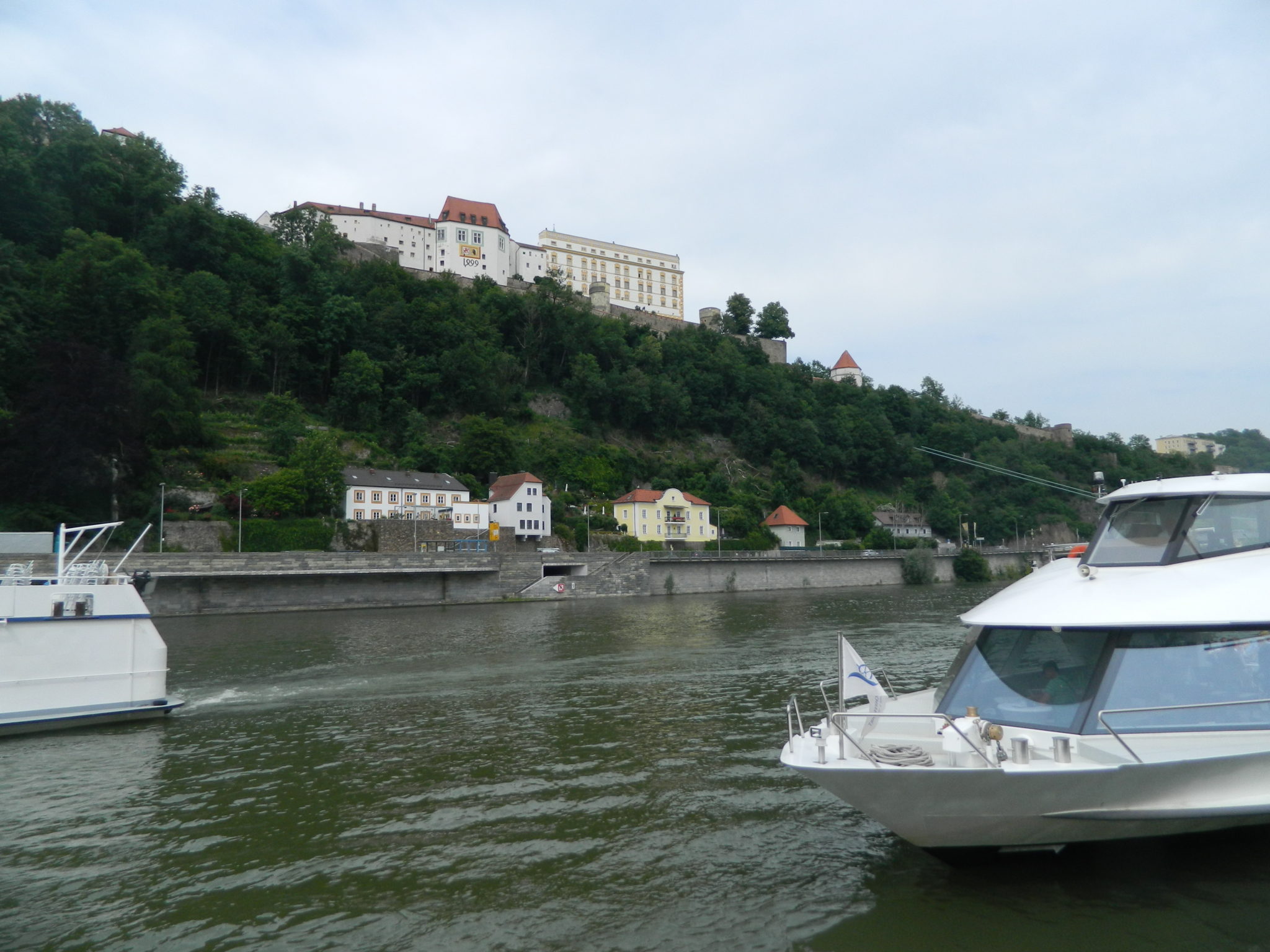
In the meantime, if one is around, I can think of nothing better than to visit this picturesque town and happen across some of its lowest-to-the-ground residents. You will be welcomed in open (stubby) arms … as long as you crouch down enough to be in their reach.
Next, we are off to northern Italy: Torino (Turin) and Milano (Milan). I am still a bit backlogged on posts, but am getting there eventually! I mean to move into my new apartment in Vancouver this week/weekend (which is also Pride) too. Busy/great … So, I should be refreshed and housed and ready to share more about summer destinations in the Mediterranean soon. Stay tuned!
